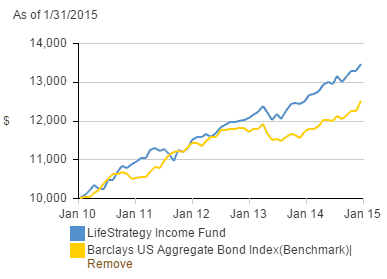Some advisers tell us it can start off with as little as $1,000 (I believe that one is a Dave Ramsey thing). More commonly I see suggestions to have as much as 3 months, 6 months, even 12 months worth of living expenses set aside in easily accessible bank account.
Fortunately for my wife and I we have done a pretty good job of building up our rainy day fund over the years to as much as $20,000! That’s a pretty admirable amount and it would easily cover around 4-5 months of our living expenses should anything awful ever happen to us.
Back when we only had $5,000 or even $10,000 in that fund, I would have never given a second thought to keeping that money parked in our boring-ole savings account. The money was good and safe, and I didn’t really care if it was only earning a meager 1% interest rate.
However … now that this pot of money is starting to get pretty healthy, this leaves me wondering: Should I be doing something more with it?
Don’t Get Greedy!
Now obviously I understand that the goal of a rainy day savings fund is to have money when you need money fast!
If you remember back in 2013 we had to drain over $5,000 in unexpected car repairs – that was awful! So just in case history decides to repeat itself, I’ll want that money where I get it fast – like within less than a week. That means that’s a no-go for investing in anything risky or speculative: No stocks, no peer-to-peer investing, etc.
So with greed removed, I’m simply asking the question: Is there a better way to optimize my returns without compromising liquidity or loss?
I feel with such a larger volume of cash on hand that it would almost be irresponsible for me NOT to at least investigate the issue a little deeper. Earlier this year when we did a similar analysis of what to do with $200 extra dollars in our budget, we found out that over time the difference in choices could have resulted in over $17,000 over the years!
So if I’m only earning 1% interest right now, is there a way I can bump that up to 2, 3, or even 4% without a lot of risk? Doing so would take the $200 I’m on track to earn and bump it up to as high as $800!
Interest Rates Were Better Back Then:
Having an emergency fund in your savings account was so much easier 10 years ago than it was today. Back then I had an ING Direct online savings account paying 5% interest. What a dream come true that would feel like right now!
Back when I was in high school I had CD’s paying as high as 5 or 6%. If I could get a return like that this whole thing wouldn’t even be an issue.
But unfortunately as long as the Fed keeps rates artificially low, we’re going to have to be a little more creative than that.
So where should we look?
My Great Compromise for Your Rainy Day Savings:
One place I’ve been looking for a possible solution is with old-fashioned mutual funds. If you ever look through the product line-up on Vanguard, you’ve probably skipped over the bond and balanced funds in hopes of finding bigger, sexier returns with the more aggressive stock and exotic-style funds.
But we’re not after big and aggressive. We want safe and steady! So let’s take a step back and look at the less-aggressive, more “boring” type of funds … starting with bonds.
Bond funds are okay. But in case you’ve never really looked very deeply into this category you’d find that bond values can fluctuate just as much as stocks (just not quite as high or low as stocks would). Can we do a little better with volatility by adding some diversification to the mix?
Yes we can! And one fund that has caught my attention is the LifeStrategy Income Fund (VASIX) from Vanguard. It invests 80% of its assets in bonds (both domestic and international) as well as 20% in stocks (also domestic and international).
Even though it’s categorized as one of the lower risk funds (2 out of 5), it still produces (in my opinion) some very acceptable returns. Almost 5% historically!
But here’s what else is drawing me to this fund. Notice what happens when you compare it to a popular bond fund index:
Did you notice how both seem to have relatively the same (perhaps less) amount of fluctuation? However the LifeStrategy Income fund produces better returns over time. That’s what’s nice about finding a hybrid fund with just the right mixture of stocks and bonds – you get the best of both worlds!
Ultimately I feel like this fund is very good compromise of the things I’m looking for. So what I’ve decided to do is take half of our emergency savings and put it into this Vanguard while the other half remains safe and sound in our online savings account. My thought there is that if we can resist touching at least one half of the entire “pie”, then that would allow this money to grow at a much more rapid rate with returns closer to what I’m after.
And who knows – if we can do a really good job of not touching any of the rainy day fund, then perhaps we can divert more of it to this account. But let’s not get ahead of ourselves too far. I’d like to monitor things and see how they go for a year.
Readers – How do you feel about taking on a little more risk for a little more return with your rainy day savings fund? Where do you keep your emergency fund and why?
Featured Image courtesy of Timitrius | Flickr




I have taken care of my emergency fund. I fee like it can cover my family’s expenses for 4 months. Thinking about it and making it cover for more months are really encouraging to increase my savings. I wish there would be no sudden expenses that would use part of my emergency fund.
First off: Nice job having 4 months worth of savings ready to go! It is kind of sad though to think that money could be gone in the blink of an eye if there was some disaster. I’d much rather use it for investing or to fund another side-business project. But I know it’s rightful place is staying put in case an emergency strikes.
I remember the days of 5 and 6% CDs. I wish I could get one of those babies right now!
Our e-fund is parked in the saddest “high interest” savings account in the world. It’s sad because the high interest part yields only about 1%. Fortunately, I don’t keep nearly as much money in our savings as I once did.
Could you imagine walking into a bank TODAY and getting a 6% CD? It would be the easiest 6% I’ve made in a long time. I’d take out the longest term CD I could get my hands on and make that puppy last!!
We’ve been thinking of this ourselves some as our EF gets up there in value. Which, a huge part of that, is because of being self-employed. We’ve been using Discover Bank but know we could likely do better but have been hesitant to add on more risk. If we do something like this we’d likely take something like 1/3 – 1/2 of the EF and invest it. One question – what’s the timeframe for the bonds in the fund? Are they short-term or longer term?
Adding on more risk is a bit concerning; especially when you’re talking about money that is supposed to be locked up and ready to go anytime you need it. But in this case doing a 1/2 bank account and 1/2 Vanguard investment in a low risk fund, I believe the chances of disaster are sufficiently mitigated.
The Vanguard fund invests in intermediate-term Treasury bonds.
Can you give me a second choice so that I can divide my emergency fund into two different investments.
Sure. The Vanguard Wellesley Income Fund was another one that I was looking at. It has similar intentions to the one I selected but the asset allocation is a bit heavier on stocks and therefore considered to be a bit more risky.
I’m content parking my emergency fund in an Ally money market account earning 0.99%. I do not like to invest in the stock market unless my time horizon for needing the capital is greater than 5 years. Plus if I ever needed the money, I wouldn’t have to worry about any capital gains or losses, I just pay ordinary income taxes (sucks but it is what it is) every year and they money is available instantly if I were to ever need it. I’ll use my other post-tax investing to yield some riskier returns.
Fair enough. That’s why I decided to only invest half my emergency fund. I wanted to make sure I had a decent chunk ready to transfer at the drop of a hat if need be.
Simple savings account for the immediate funds. We have additional funds in other accounts we can access without penalty if needed, depending on the severity of the expense.
I keep looking at CDs, online savings accounts, etc. but haven’t found anything better that meets my needs.
ZIRP is wreaking a devastation upon the average citizen much worse than letting the “too big to fail” to fail.
You’ve got that right. With the number of years ZIRP has been in effect it has really contributed in a very bad way to the decline of the middle class. I’ve seen a number of articles now where not being able to get a decent safe rate of return (like we used to with banks and CD’s) has really hurt the Average Joe.
I’m ok keeping my efund totally liquid. The risk you take investing in bonds right now is they work inversely to interest rates. Their performance numbers are going to include the last 7 years of low rates. When interest rates rise in the next couple of years the bond values will fall. This is why you still see so much volatility in bond funds. You need to check on how that fund performed back in the days of those crazy high interest rates!
Good point. Inherently treasury bonds to a have an inverse relationship with interest rates. Fortunately I believe the stock and international elements of the fund will help keep it stabilized just enough to produce returns beyond what my savings account produces.
I don’t think that’s a bad strategy at all. Keep enough for that car repair or deductible in a savings account and put the rest into something with more of yield. Since we have rentals, I think we have to keep most of our e-fund in a basic savings account. It would be nice if the interest was a bit more, but the low rates have allowed us to buy our properties, so I guess there are always positives and negatives.
That’s a unique position to be in. With the uncertainty that comes with being a landlord (my father in law has told me many horror stories) I would definitely play it smart like you and keep it all liquid in the basic savings account. You never know what could happen.
I currently have my emergency fund split into three parts: cash (in my safe), savings account 1.1% APY and physical gold and silver. I have 2/3 of the cash in my savings account so I’m also thinking of putting half of if to similar wealth management fund now I only wish I could see how it behaves in bear market.
I love the fact that part of your e-fund is in physical gold and silver. That’s the first time I’ve ever heard anyone say they do that.
As of right now I have 6 months of cash on hand ready in case of emergencies. (Like a layoff or car repairs) I like the idea of investing half, and when my EF reaches a threshold that is too high, I move it over to mutual funds as well. If an emergency occurs and you need those invested funds, the taxes you will pay is non factor, if it will help you avoid adding debt. Hopefully with all the dividends you earn, it can double in the next 10 years.
Great job having 6 months worth of expenses covered! It sounds like we have very similar attitudes on lending out a portion of our EF to higher producing investments.
We do this. We keep about $5K in cash and then invest the rest in GNMA bonds or some other relatively safe bond fund. The thinking goes – we can cover most major expenses with the $5K. If it costs more, we use the credit card and then just sell some of the holdings to pay off the credit card/replenish the emergency fund balance.
Most people would probably frown using credit cards to pay for their emergencies, but I do a similar thing. When we had our $5K of mystery vehicle expenses we put the whole thing on our credit card and then paid it off when the bill came due (incurring no interest).
For me I believe that Money Market funds are best for keeping my emergency funds as it is easily accessible and I earn much more than then fraction of a percentage a regular savings account with the bank offers. However I like the 5% with the Vanguard Lifestrategy fund you mentioned, you said it low risk so it might be worth switching to or at least putting half of my emergency fund into.
Good idea to split up emergency fund! How liquid is the VG fund you talk about though? If after a few months of being unemployed, how do I get my hands on it?